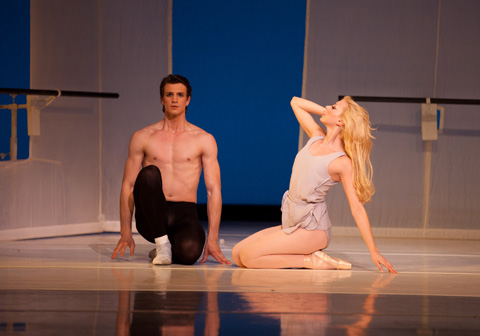
AFTERNOON OF A FAUN Sabi Varga and Whitney Jensen ask their mirror who’s the fairest of them all. |
After the frenetic gutbusting of its Elo Experience and "Bella Figura" programs, Boston Ballet is closing out its 2010–2011 season with a breath of classical fresh air — or so it would seem. "Balanchine/Robbins" sandwiches two Greek-inspired Jerome Robbins pieces, Afternoon of a Faun (1953) and Antique Epigraphs (1984), between two of George Balanchine's most magisterial creations, Divertimento No. 15 (1956) and Symphony in Three Movements (1972). The poster for the program has Balanchine and Robbins looking as if they were out to one-up each other in some firecracker out of West Side Story, but what's on stage is mostly measured, and it'll take the measure of your mind. It's also a reminder that Mozart can be a lot harder to dance to than Thom Willems.Divertimento No. 15, which the company has done previously in 1999 and 2004, is set to Mozart's Divertimento in B-flat K.287 for strings and two horns — a piece that, like Balanchine's dance, is wittier and more subversive than its placid surface suggests. What sounds like sublime elegance is undercut by the composer's use of popular songs: "Heissa, hurtig, ich bin Hans und bin ohne Sorge" ("Ardent, agile, I'm Hans, without a care in the world") for the second-movement theme and variations and "D'Bäuerin hat d'Katz verlorn, weiß nit wo's is" ("The peasant girl's lost the cat, doesn't know where it is") in the finale. And just as the musicians have to make Mozart's difficult writing (the high tessitura for both horns and strings) sound easy, so the dancers have to make Balanchine's simple-looking combinations look free and light or else they'll look like nothing.
It all starts innocently enough. Eight corps women in Maryinsky-ice-blue tutus are joined by Dalay Parrondo and Rie Ichikawa in gold — seeming demi-soloists, ladies-in-waiting, perhaps. Those two rush off and three gold-jacketed men — John Lam, James Whiteside, and Jaime Diaz — come on, followed by three gold-tutu'd women — Erica Cornejo, Lorna Feijóo, and Tiffany Hedman. They pair up, and everything seems in order, until Parrondo and Ichikawa return and slot in among the ladies, and you realize that there's no hierarchy here — all five women are wearing identical tutus. It's one and two-thirds girls for every boy.
For the second-movement theme and six variations, Balanchine gives the theme to two of the men — here Lam and Diaz — and a variation to each of the remaining soloists. One by one, Parrondo, Cornejo, Ichikawa, Hedman, Whiteside, and Feijóo strut their stuff. Then there's a minuet for the corps ladies, whose childhood games suggest they don't feel (or perhaps have outgrown) the need for men.
The adagio is a series of pas de deux in which the men appear to have made their choice: Lam dances with Cornejo, Diaz with Parrondo, Whiteside with Ichikawa. But it's not over: here's Lam again, this time with Hedman, and now Whiteside is back with Feijóo. Eventually, the women form upstage left and the men downstage right; the two groups bow to each other and then back out. In the allegro finale (Balanchine having omitted the second minuet and the andante that begins Mozart's finale), the men are at full stretch to keep the women engaged, moving quickly from one to another or dancing with two at once. The corps, meanwhile, take no notice of these partnering shenanigans; they look as assured and expectant as if they were attending a royal triple wedding.